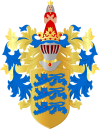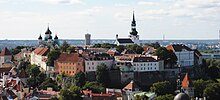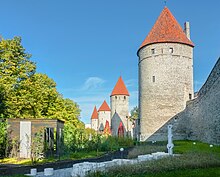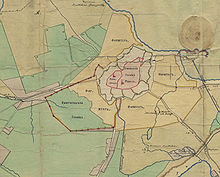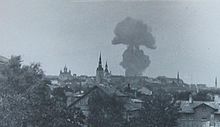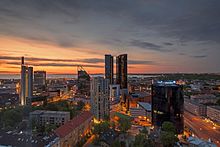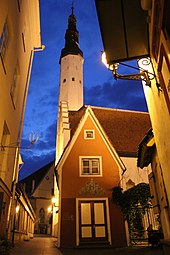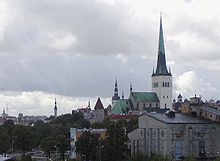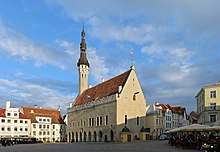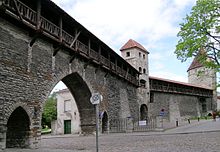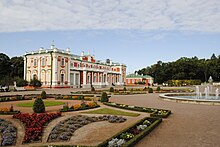Tallinn
| Tallinn | |||
|
|||
| State : |
|
||
| Circle : |
|
||
| Founded : | 1230 (Luebian law) | ||
| Coordinates : | 59 ° 26 ' N , 24 ° 45' E | ||
| Height : | 44 m | ||
| Area : | 159.2 km² | ||
| Residents : | 434,562 (2019) | ||
| Population density : | 2,730 inhabitants per km² | ||
| Time zone : | EET (UTC + 2) | ||
| Telephone code : | (+372) 6 | ||
| Postal code : | 15080 | ||
| License plate : | FROM | ||
| Community type: | city | ||
| Mayor : | Mihhail Kõlvart | ||
| Postal address : | Vana-Viru 12 15080 Tallinn |
||
| Website : | |||

|
|||
Tallinn (German pronunciation [ ˈtalɪn ], Estonian pronunciation [ ˈtɑlʲˑinˑ ]) is the capital as well as the economic and cultural center of Estonia and with around 430,000 inhabitants also by far the largest city in the country. It is located on the Gulf of Finland in the Baltic Sea , about 80 kilometers south of Helsinki .
Until February 24, 1918, Tallinn was officially called Reval [ ˈʀeːval ], a name that was still used in German-speaking countries afterwards. In Low German the name is Revel . Other older names are Russian Ревель (Rewel) and formerly Колывань (Kolywan) , Danish Lyndanisse , Swedish Lindanäs or Reuel .
Tallinn has been called Tallinn in Estonian since it was conquered by the Danish King Waldemar in 1219. It is usually derived from Taani-linn (a) , which means "Danish city" or "Danish castle" ( Latin Castrum Danorum ).
geography
climate
Tallinn is characterized by a cold climate. The highest rainfall is recorded in August.
| Tallinn | ||||||||||||||||||||||||||||||||||||||||||||||||
|---|---|---|---|---|---|---|---|---|---|---|---|---|---|---|---|---|---|---|---|---|---|---|---|---|---|---|---|---|---|---|---|---|---|---|---|---|---|---|---|---|---|---|---|---|---|---|---|---|
| Climate diagram | ||||||||||||||||||||||||||||||||||||||||||||||||
| ||||||||||||||||||||||||||||||||||||||||||||||||
|
Average monthly temperatures and rainfall for Tallinn
Source: wetterkontor.de
|
|||||||||||||||||||||||||||||||||||||||||||||||||||||||||||||||||||||||||||||||||||||||||||||||||||||||||||||||||||||||||||||||||||||||||||||||||||||||||||||||||||||||||||||||||||||||||||||||||||
City structure
Tallinn is divided into the districts Haabersti, Kesklinn, Kristiine, Lasnamäe, Mustamäe, Nõmme, Pirita and Põhja-Tallinn as well as 84 districts .
- Haabersti : Astangu , Haabersti , Kakumäe , Mäeküla , Mustjõe , Õismäe , Pikaliiva , Rocca al Mare , Tiskre , Väike-Õismäe , Veskimetsa , Vismeistri
- Kesklinn : Aegna , Juhkentali , Kadriorg , Kassisaba , Keldrimäe , Kitseküla , Kompassi , Luite , Maakri , Mõigu , Raua , Sadama , Sibulaküla , Südalinn , Tatari , Tõnismäe , Torupilli , Ülemistejärve , Uus Maailm , Vanalinn , Veerenni
- Kristiine : Järve , Lilleküla , Tondi
- Lasnamäe : Katleri , Kurepõllu , Kuristiku , Laagna , Loopealse , Mustakivi , Pae , Paevälja , Priisle , Seli , Sikupilli , Sõjamäe , Tondiraba , Ülemiste , Uuslinn , Väo
- Mustamäe : Kadaka , Mustamäe , Sääse , Siili
- Nõmme : Hiiu , Kivimäe , Laagri , Liiva , Männiku , Nõmme , Pääsküla , Rahumäe , Raudalu , Vana-Mustamäe
- Pirita : Iru , Kloostrimetsa , Kose , Laiaküla , Lepiku , Maarjamäe , Mäh , Merivälja , Pirita
- Põhja-Tallinn : Kalamaja , Karjamaa , Kelmiküla , Kopli , Merimetsa , Paljassaare , Pelgulinn , Pelguranna , Sitsi
neighborhood
Tallinn is bordered by Viimsi to the northeast, Jõelähtme to the east, Rae to the southeast, Saku to the south, Vasalemma to the southwest and Harku to the west .
history
The origins of Reval go back to a wooden castle (on today's Toompea ) and a supposed Estonian trading center, which were built in the middle of the 11th century. At the same time, the port of Tallinn was built at this time. The name Reval comes from the Estonian name of the historical district, the center of which was the city, and was first coined for the castle and the later city by Danes and Germans ( Estonian also Rävälä , after Heinrich von Latvia Revele, according to the Waldemar earth book Revælæ ).
Danish rule
In 1219 the Danish King Waldemar II conquered the old Estonian castle ( Battle of Lyndanisse ) on Toompea, rebuilt it and began building a cathedral for the Estonian bishop, Suffragan des , who was appointed by Denmark around 1167 in the course of his missionary work Archbishop of Lund . However, Denmark could not hold the castle long against the rebellious Estonians and the advancing Germans. In 1227 the Brothers of the Sword conquered Reval with papal approval and received the castle and much of what is now Estonia for administration from the papal governor in Estonia.
Probably in order to strengthen its position against the rural vassals , the Brothers of the Sword Order recruited 200 Westphalian and Lower Saxon merchants from Gotland in 1230 , who settled below the castle with exemption from customs duties and land. Although a charter of founding has not been handed down, this is probably the actual founding of a city of Reval.
When the order refused to hand over its feudal lords and the castle to the papal legate three years later , the Danish king reasserted his claims to Reval and Estonia. After the devastating defeat in the Battle of Schaulen in 1236, the Order of the Brothers of the Swords sought to merge with the Teutonic Order , which the Pope only approved against the surrender of Reval. In 1237 the Brothers of the Sword became part of the Teutonic Order as the Livonian Order , and Reval fell to Denmark in 1238. In this context, Reval was mentioned for the first time as civitas (citizenry, city).
Under the renewed Danish rule until 1346, the city quickly grew in size and economic importance. 1248 she received the Danish king Lubeck city charter , which was valid until 1865th However, this did not apply to Toompea. The same charter was used to appoint the first councilors . The city gradually received extensive privileges that made it largely independent of the sovereign . The official language in Tallinn was German until 1889.
Although Reval was under (increasingly loosely) Danish rule, the city retained a German upper class, and since this consisted almost exclusively of merchants, close contact with the Hanseatic League was maintained. The fact that Reval considered itself to be part of the Hanseatic League can already be documented for 1252 and is explicitly mentioned in 1285 at the latest. The Danish decision of 1294 to allow all German merchants to travel to Novgorod via Reval and Narva was of economic importance . This enabled Reval to become a hub of the Hanseatic Baltic Sea trade .
Reval and the German Order

After the suppression of a great Estonian uprising with the help of the Teutonic Order, the Danish king released his Estonian vassals from their oath of allegiance in 1346 and sold his rights to Northern Estonia to the Teutonic Order. Reval, which had all existing and some new privileges confirmed by the Danish king in the year before the sale, was now assured of all privileges by the new sovereign and was thus able to expand its legal and autonomous position during the change.
Reval, part of the "Livonian Third" of the Hanseatic League, was given the right of stacking together with Riga and Pernau in 1346 , which obliged all merchants trading with Russia to call at one of the three cities and to keep their goods on the market for a period of three to eight days to offer. Several exclusive trading rights for the Reval merchants ended the free trade that had been open to everyone in the city. The previously most important trading town in the Baltic Sea, Wisby , was unable to recover to its previous position of supremacy after being plundered by the Danish king in 1361 and in the following war years, and when the Vitalien Brothers were banned from the Baltic Sea at the turn of the century , Reval was the most important City of the Hanseatic East Trade.
However, trade with Russia did not always remain untroubled. After several uncertain years, trade with Novgorod was completely broken off in 1471 due to attacks by the Muscovites, and in 1478 the previously independent principality was finally conquered by the Muscovites. The Grand Duchy of Moscow waged war against Livonia , with which it now shared a border. The invasion of Livonia by Moscow Russians in 1481 brought a severe plague outbreak to the city, which was overcrowded with refugees. Other years of severe disease in the city were 1464, 1495/96 and 1519/20. After a short period of peace, in which the Novgorod trading office was reopened and closed again, a successful campaign by the Teutonic Order against Moscow followed from 1501–1503, followed by a peace that lasted until 1558.
The wars with the Moscow Russians brought heavy economic and population losses for Livonia and Reval. It was not until 1514 that a new trade relationship between the Livonian cities of Reval and Dorpat and Novgorod was successfully established , which led to a more recent economic boom until the 1550s. In the 16th century the city had about 6000–7000 inhabitants.
The Reformation reached Reval in 1523/24. It experienced its final breakthrough when, in July 1524, representatives of the Livonian cities and knights gathered in the town hall of Reval and decided to stick to the Protestant doctrine and defend it by all means. In September 1524 there was an iconoclasm that destroyed the furnishings of three churches. The losses remained relatively small, as the council was able to restore public order the next day and ensure that the stolen art treasures were returned. Overall, it can be said that the Reformation in Livonia and Reval was bloodless. On September 9, 1525, the new teaching in Reval became “official” through the enactment of a Lutheran church order by the council and the guilds.
Protective power Sweden and Russian rule
The remainder of the reign of the order was marked by internal and external disputes until Moscow defeated the Teutonic Order in Livonia when it invaded 1558–1561. Reval turned to Sweden as a protective power, which began a Swedish rule in the city that lasted until the Great Northern War in 1710 .
In 1549 the Olaikirche received a Gothic tower, which was rebuilt after fires in 1629 and 1820. Today it is 123.7 meters high.
In 1561 the city became Swedish during the Livonian War . The Swedes gradually reduced the privileges of the Germans , but not to the extent that the Estonians initially hoped for the status of farmers in Sweden .
- 1631: Foundation of the first grammar school
- 1684: devastating fire on the Domberg
- 1710: Plague epidemic, Reval had 2000 inhabitants afterwards
As a result of the Great Northern War , Reval fell to Russia during the siege of Reval in 1710 . Peter I put the old German councilors back in their original positions, and over the next two centuries the rights of the city government were gradually reduced.
Republic of Estonia 1918–1940
On February 24, 1918, the independent Republic of Estonia was proclaimed; the city, now called Tallinn , eventually became the capital of independent Estonia . The actual independence was in the war of liberation fought (1918-1920) and by the Peace Treaty with the Soviet Russia crowned.
Soviet Republic and World War II
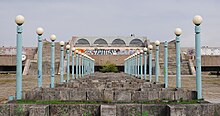
A secret additional protocol to the German-Soviet non-aggression pact (in August 1939) paved the way for the conquest of Estonia by the Soviet Union . The Baltic German population was resettled from the Tallinn port on Hitler's orders to the newly created Reichsgau Wartheland . After the Soviet occupation in June 1940, the Estonian Soviet Socialist Republic was proclaimed, the capital of which remained Tallinn. The first deportations of the Estonian population - especially the political and cultural elite - to Siberia and Northern Russia began. In the Soviet waves of terrorism after 1940 and then again from 1944/45, a total of every fifteenth Estonian was murdered and every seventeenth was deported to Siberia for at least ten years.
In 1941 the German Wehrmacht occupied Tallinn, which shifted the city and the country from one arbitrary rule to the next. Hitler pursued the goal of annexing Estonia to the German Reich . The restoration of independence hoped for by the Estonians did not take place. Nevertheless, many young Estonians took part in the advance of the German Wehrmacht to the east and took part in extermination campaigns. The German occupation forces had the Jewish population of Tallinn and Estonia almost completely murdered.
On March 9, 1944, there was a heavy Soviet air raid. Eleven percent of the old town was destroyed and 600 dead were counted. During the war, the character of the old town was preserved despite the bombing by the Soviet air force against the German troops stationed in and around Tallinn. The Wehrmacht was pushed back by the Soviet Army in the course of the Baltic Operation from Tallinn and Estonia by the end of 1944 and Soviet rule was restored. In the city there was a prisoner of war camp 286 for German prisoners of war of the Second World War .
Republic of Estonia from 1991
After 51 years, on August 20, 1991, at the time of the Moscow coup , Tallinn again became the capital of an independent Estonia . As a result of the immense economic growth and the strong increase in prosperity in some layers, huge new building areas have emerged around Tallinn within a few years. For example, in the Peetri area south of Tallinn, single and multi-family houses were built on a former moor. Young families in particular, who have benefited from economic development in recent years, settle here. There is a strong contrast to the large settlements in the socialist style. The prices for apartments in the new building areas are already partly on a western level.
At the end of April 2007, riots and looting of mainly Russian-born youth led to the strongest unrest since the collapse of the Soviet Union . The reason for this was the move of the bronze soldier from Tallinn from his original location in the city center to a military cemetery , which the Estonian authorities had ordered after a long previous announcement on April 27, 2007 . Estonians associate this monument with the Soviet occupation rather than the liberation from German occupation in World War II, to which the monument is dedicated (and which it symbolizes for Russians and the Russian minority in Estonia). As a result of the monument dispute, there was a serious crisis in relations between Estonia and Russia, which vehemently opposed the implementation of the statue.
Historical city topography
Toompea and the lower town were two autonomous towns in administration and jurisdiction until 1877.
The Toompea, on which the bishop , the representative of the sovereign, the Teutonic Order and the representative of the knighthood sat, is still the center of state power. The parliament of the Republic of Estonia (Riigikogu) and the government have their seat here. Toompea rises 48 m above the lower town.
Historically, the lower town is the actual town of Reval. Most of the city's population, craftsmen and merchants lived here. The city was independent of the sovereign. There were only small annual payments of interest and rent to be made to the order, and in the event of a solemn entry into the city, it had to pay homage to the sovereign. The city turned to Lübeck on legal issues.
bishop
The bishop was the only spiritual shepherd and not a sovereign. His property consisted of table goods in the diocese. With the loss of his episcopal rights to the city of Reval through the Luebian city law, he was deprived of his spiritual position of power. The Bishop of Reval was suffragan to the Archbishop of Lund during the religious period, but he had no influence on the election of the bishop during this period. The cathedral chapter was extremely small with four canons , and the only income available to it was pious foundations and a few villages in the Reval area. In addition to the cathedral, the Representation of the Teutonic Order and the seat of the v. a. Harrisch-wierischen knighthood only a small population of craftsmen and servants.
Population
For its relatively small area (on its longest north-south axis, the city was about 1 kilometer, less than 700 meters wide), the lower town accommodated a large number of people. There are no population figures for the entire city from the time of the order, but there is a lap list of 1538 for the lower city , which includes around 800 people, which, in comparison to later lists of residents and based on conservative estimates, suggests a population of around 5,000. The “ Wacken book” from 1575 is available for the cathedral city , with the help of which around 1000 people (together with the cathedral, order palace and vassals present) can be assumed. The suburbs are estimated according to their size in the first half of the 16th century at about 700 inhabitants, which results in a population of about 6,700 inhabitants for the entire city of Reval at that time.
Earlier estimates are likely to be even more inaccurate. A lap list from 1372 lists around 650 people subject to lap obligations. If you allow yourself the simplification and subtract the later population estimate for this year, then this, together with the cathedral city, would result in a population of perhaps almost 5,000 inhabitants (the suburbs did not exist at that time). This made Reval one of the medium-sized European cities, far from large cities with around 40,000 inhabitants such as Cologne , Vienna and Prague or with 20,000 inhabitants such as Lübeck , Nuremberg , Bremen or Danzig . In terms of population, Reval was more like cities such as Göttingen , Hildesheim or Stockholm , although the numbers could fluctuate greatly due to the economy, wars and epidemics.
Most of the citizens of Reval were German and, unless they were born in Reval, came from the Reich. Throughout the Middle Ages, Lübeck was the transit station and occasionally the home town for new residents of Reval. The long-distance trade merchants, spread across the Hanseatic cities, formed a dense social network, often through relatives, so it is not surprising if a family was in Reval, Lübeck and other Hanseatic cities at the same time. An examination of the place names occurring in Reval citizens' names in the 14th century showed that about half of all place names can be found in the Rhenish-Westphalian area, the other half is mainly composed of the entire north German area.
Social composition of the population
The social life of the city was determined by the family or the neighborhood to a large extent by the occupational groups, the guilds and the three guilds , the children's or large guild , the Kanegilde and the Olaigilde , with the sociability within these cooperatives half professional, half private sphere was created. The guilds were founded as church corporations, but soon united the respected professions and guilds and had important social functions. They celebrated their members' funerals and weddings together, held social meals and dance parties, laid down rules for good behavior (in the event of a violation, precisely specified fines went to the guild treasury) and helped each other in accidents. The guilds maintained their own altars and so-called table guilds to feed the poor . The existing guild houses for the guilds have been preserved in the old town of Reval, for example the house of the Great Guild .
Nationality (descent or country of origin) was a strict social differentiator . The city was essentially made up of three nationalities, Germans, Swedes and Estonians (the so-called non-Germans ), and the lap list of 1538 gives the following picture: About a fifth of the population required to be shot seems to have been Swedish, two fifths each German and Estonian. In terms of their social ranking, the entire upper class and more than half of the middle class were probably made up of Germans. About a quarter of the rest of the middle class is made up of Swedes and a fifth of Estonians. Three-quarters of the lower class consisted of Estonians and, apart from a few Germans, of Swedes. In this case, the social stratifications were based on the lap payment and the living situation.
The national composition of Toompea can only be judged very carefully, as the main source, the Wackenbuch from 1575, dates from the time of Swedish rule. With the change of the sovereign, there will have been a change in the composition of the population of the cathedral city, the seat of the sovereign, especially since with the many Swedish names listed in the Wacken Book it cannot be ruled out that the Swedish scribes simply wrote down German names in Swedish form. For the time of the order, however, it can be assumed that the upper class was composed almost entirely of Germans, the lower class largely of Estonians.
Parishes
The two parishes of the lower town correspond to two different urban germ cells. On the one hand, the southern part of the city is characterized by the old market and the star-shaped streets from it. An Estonian trading center presumably already existed here at the level of the connection path to Toompea, the infrastructure of which was taken over by the 200 German merchants who were called. The parish church responsible for this part of the city, St. Nikolai , was first mentioned in a document in 1316, but probably dates back to the second half of the 13th century and is certainly a foundation of German merchants. As in many other Hanseatic cities, it is dedicated to Saint Nicholas , the patron saint of seafarers.
On the other hand, the long northern part of the city is determined by Langstrasse , the main road connecting the port and Toompea, where mainly Swedish and Russian merchants settled. The parish church there, far to the north of the city, is St. Olai, first mentioned in 1267, when the Danish Queen Margrete I gave her parochial rights over the church to the Reval Cistercian convent of St. Michael. How far back the origins of this church goes back to the past is unknown, but it can be assumed that it was either founded by the Danish king or by Swedish merchants who probably had a trading post here before the city was founded. It is named after the canonized Norwegian King Olav . After the great fire in 1433, which devastated the monastery of St. Olai, the mint and part of the market square, the church became the property of the city. The Russian church, which stood not far from St. Olai, shows that the northern part of the city was originally populated by strangers. Both parts of the city were joined together in 1265 on the orders of the Danish Queen Margrete I and surrounded by a city wall.
Monasteries and chapels
Within the city wall there are two monasteries: one of the Dominicans and one of the Cistercian women . The Dominican monastery at St. Katharina was probably first built on Toompea in 1229, but was re-established in the city in 1246 and maintained close ties to the Scandinavian Dominicans. It was very popular with the citizens throughout its existence, which was reflected in strong material growth through donations and foundations. As a result of their preaching activity, the Dominicans repeatedly came into conflict with the bishop and, during the Reformation, in serious disputes with the city, which ended in 1523 with the expulsion of the monks from the city.
The Cistercian convent was probably founded in 1249 by the Danish king. The church was consecrated to St. Michael and, together with the monastery, only became part of the inner city structure when the city wall was expanded. The monastery was very richly endowed with privileges by the Danish royal family, acquired large properties early on and took in mostly unmarried daughters of the nobility, which explains its relatively poor relationships with the bourgeois townspeople. After the Reformation it was converted into a female educational institution.
In addition to the local monasteries, some foreign monasteries had farms in Reval. The court of the Cistercian monks of Dünamünde (later by Padis ) is not mentioned until 1280, but it has existed since the first Danish rule. Right next to it was the court of the Gotland Cistercians from Roma , and opposite this was the court of the Cistercians from Falkenau near Dorpat on a property that was given to them in 1259.
In 1316 the Holy Spirit Chapel belonging to St. Olai is mentioned for the first time, which already had the status of an almost independent church and was mainly visited by the urban non-Germans . The Holy Spirit Hospital for the elderly and the sick, built on the Roman model, belonged to it. The Johannisspital, which was first mentioned in 1237, was much older. It was built as a leprosy and was continued as an infirmary after the leprosy disappeared.
Outside the city wall, in front of the forge gate, there was the Barbara chapel with a churchyard , which belonged to St. Nikolai and whose construction is estimated to be in the first half of the 14th century. The chapel no longer exists today; it was probably destroyed during the Russian siege in 1570/71. Also outside, near the harbor, in front of the large beach gate, was the Gertruden chapel, built for boaters and travelers. Its construction was permitted in 1438, but in 1570 it was destroyed in a fire. On the Tönnisberg (Antoniusberg) stood the Antonius Chapel, the original purpose of which can no longer be reconstructed.
The construction of the Augustinian monastery of St. Brigitten zu Marienthal , which began in 1407, was completed by its consecration in 1436 at the latest, whereby the monastery was given the Augustinian rule in 1411 and the subsidiary Marienwohlde near Lübeck was founded in 1412 . The founders were three Reval merchants who later joined the convent . The monastery was located near the coast, four kilometers northeast of the city, on the border with the city march and was first mentioned in a Reval will in 1435. It was used to accommodate people of both sexes, but the women, mostly bourgeois daughters, predominated, who mostly provided the abbess . The monastery was destroyed during two Russian sieges, 1575 and 1577.
population
Population development
| year | Residents | Timeline of population development since 1710 |
|---|---|---|
| 16th century | 6-7,000 |

|
| 1710 | approx. 2,000 | |
| 1870 | approx. 31,000 | |
| 1934 | 137,792 | |
| 1945 | 127,000 | |
| 1959 | 281.714 | |
| 1970 | 369,583 | |
| 1979 | 441,800 | |
| 1989 | 499.421 | |
| 2003 | 386,000 | |
| 2005 | 401,694 | |
| 2007 | 396.200 | |
| 2012 | 416.434 |
According to the 2011 census, there is a very different picture with regard to the population groups by mother tongue in relation to the various districts. A large part of the Russian-speaking population (mainly Russians, Ukrainians, Belarusians, Tatars) live in the large residential block districts on the outskirts, such as Lasnamäe, Väike-Õismäe and Astangu (Haabersti district) as well as Kopli, Pelguranna and Karjamaa (Põhja-Tallinn district), which were developed during the Soviet era ).
The inner city (Kesklinn district), the Kristiine and Nõmme districts, which are characterized by the construction of individual houses and smaller residential complexes, and the Pirita district in the north-east are predominantly inhabited by people with Estonian mother tongue. Mustamäe district with its v. a. The large housing estates built during the Soviet era are also multilingual, as are parts of the Põhja-Tallinn and Haabersti districts in the north and northwest of the city.
The following table provides an overview of the distribution of the population by mother tongue according to the 2011 census:
| Borough | Residents | native language | |||||||
|---|---|---|---|---|---|---|---|---|---|
| Estonian | Russian | Other | Unknown | ||||||
| Ew. | % | Ew. | % | Ew. | % | Ew. | % | ||
| Haabersti | 41,694 | 20,919 | 50.2% | 19,722 | 47.3% | 1,020 | 2.4% | 33 | 0.1% |
| Kesklinn | 46,494 | 34,293 | 73.8% | 10,506 | 22.6% | 1,548 | 3.3% | 147 | 0.3% |
| Kristiine | 29,228 | 20,862 | 71.4% | 7,740 | 26.5% | 594 | 2.0% | 33 | 0.3% |
| Lasnamäe | 108.042 | 27,876 | 25.8% | 76,518 | 70.8% | 3,474 | 3.2% | 174 | 0.2% |
| Mustamäe | 62,255 | 36,444 | 58.5% | 24,333 | 39.1% | 1.314 | 2.1% | 165 | 0.3% |
| Nõmme | 35,463 | 30,261 | 85.3% | 4,650 | 13.1% | 522 | 1.5% | 30th | 0.1% |
| Pirita | 16,165 | 12,417 | 76.8% | 3,378 | 20.9% | 336 | 2.1% | 33 | 0.2% |
| Põhja-Tallinn | 53,881 | 25,638 | 47.6% | 26,703 | 49.6% | 1,434 | 2.7% | 105 | 0.2% |
| Tallinn city | 393.222 | 208.711 | 53.1% | 173,551 | 44.1% | 10,241 | 2.6% | 719 | 0.2% |
religion
Tallinn is the seat of the consistory and the archbishop of the Estonian Evangelical Lutheran Church . The Roman Catholic Apostolic Administration of Estonia has its seat at St. Peter and Paul . Tallinn is also the seat of the Metropolitan of the Estonian Apostolic Orthodox Church, part of the Ecumenical Patriarchate of Constantinople , and the Metropolitan of the Estonian Orthodox Church of the Moscow Patriarchate . The majority of Estonians today are non-denominational. The Estonian- and Russian-speaking followers of the two Orthodox Churches formed the largest denomination among the inhabitants of Tallinn in 2000 with a share of 18.3%. The Lutherans followed with 11.4%.
In 2015, the Community of Protestant Churches in Europe awarded Tallinn the honorary title of “ Reformation City of Europe ”.
Politics and administration
Capital
Tallinn is the capital of the Republic of Estonia. The city is home to the President , the Government, the Parliament ( Riigikogu ), the Ministries and numerous diplomatic missions.
administration
The members of the Tallinn City Council are elected every four years. The last election of the 79 councilors took place on October 15, 2017. One of the tasks of the city council is the election of the mayor. Mihhail Kõlvart has held this post since April 2019 .
With 40 council members, the Estonian Center Party (Eesti Keskerakond) has an absolute majority, 18 members are the liberal Estonian Reform Party (Eesti Reformierakond) , nine are the social democratic Sotsiaaldemokraatlik Erakond , six are the national conservative Eesti Konservatiivne Rahvaerakond and the conservative Isamaitica ja Resvaerakond is five . The long-standing mayor Edgar Savisaar , who ran as an independent candidate, was able to achieve the 79th mandate .
The Tallinn city government is the executive body and includes six deputy mayors in addition to the mayor.
Symbols
The flag of Tallinn has three horizontal blue and three white stripes. The city's coat of arms features three lions , one of the oldest Estonian symbols, and has been in use since the 13th century.
Twin cities
Tallinn has partnerships with the following cities:
Cityscape and architecture
View of the city from the tower of Olaikirche (May 2016)
Tallinn Old Town (Estonian Vanalinn ) was added to the UNESCO World Heritage List in 1997 as an "exceptionally complete and well-preserved example of a medieval northern European trading town".
Lower town
The center is the town hall square (Estonian Raekoja plats ), which is surrounded by the Gothic town hall, first mentioned in 1322 but built in the 13th century, and other stately buildings. The publicly accessible viewing platform of the town hall offers an excellent view of the city, harbor and bay. The symbol of Tallinn - the figure of the town servant " Old Thomas " (Estonian Vana Toomas ) - has adorned the spire since 1530. The two dragon-shaped gargoyles are from the 17th century.
Opposite is the Ratsapotheke (Estonian Raeapteek ). It was first mentioned in a document in 1422, making it one of the two oldest still active pharmacies in Europe (the other is in Dubrovnik ). After renovations in the 16th century, the Johann Burchart family from Hungary rented the pharmacy and ran it for over 300 years.
The city wall is one of the main attractions of the city. In the Middle Ages, Tallinn was one of the best fortified cities on the Baltic Sea. The construction of the fortifications began in the second half of the 13th century and continued for the next 300 years. Since the weapons became more and more powerful, they had to be continuously improved. The finished wall was ultimately 2.35 km long, 13-16 m high and 2-3 m thick and had over 40 towers. Today there are still 1.85 km of wall and 26 towers. The clay gate was one of the main gates of medieval Tallinn, which was rebuilt several times. Only the front gate of him remains today. The city wall had six gates (gates) in the Middle Ages, all of them had one or two front gates, suspension bridges over the moat and portcullis. The Great Beach Gate with Fat Margaret . When the Great Beach Gate was built, it was so close to the shore that the waves lapped at the gate in a storm. The entrance gate with the big Margarethe cannon tower, whose diameter is 25 m, has been preserved. Today it houses the Estonian Maritime Museum , which gives an overview of the history of seafaring and fishing.
The Kiek in de Kök , a former cannon tower from the 15th century, which at the time was the strongest cannon tower in the Baltic States , is worth seeing . Other towers of the Reval city fortifications are the Golden Foot , the Loewenschede Tower , the Reeperbahnturm and the Epping Tower .
The St. Nikolaikirche (Estonian Niguliste kirik ), a late Gothic stone church, dates from the beginning of the 13th century. The main altar by Lübeck master Hermen Rode from 1481 and the fragment of the dance of death by Lübeck master Bernt Notke are worth mentioning . It is an example of the “merchant churches” that were widespread in the 13th century (the roof structure of the church served as a warehouse). It also served as a fortified church. From the 15th century it was converted into a basilica. It was the only church to survive the iconoclasm of the Reformation period because, as it is said, the church chief had the door locks poured out with lead. After being severely damaged by a bombing raid in 1944, the church is now a museum and concert hall. South of the church is the oldest tree in Reval, the chalice lime . In the Rader Road (Rataskaev) is the already mentioned 1375 wheel wells .
The Heiliggeistkirche (Estonian Pühavaimu kirik ), built in the 14th century as a chapel to the Heiligengeist arm hospital with two functions: Church of the poor house and council chapel. It has a late medieval winged altar by the Lübeck master Bernt Notke from the 15th century and a clock from the 17th century, made by the master Christian Ackermann .
The Olaikirche (Estonian Oleviste kirik ), named after the Norwegian King Olaf II , who carried out the Christianization of Northern Europe, was first mentioned in the 13th century. The tower can be climbed and offers an excellent view of the entire city. The historic horse mill and the historic building complex Drei Schwestern, used as a hotel, are nearby .
The House of the Blackheads Brotherhood : This brotherhood only existed in Old Livonia (Estonia and Latvia), it was unique in Europe. They united unmarried merchants of German descent. After joining the guild, their career led the most successful ones to the city council. The name comes from their patron saint , the early Christian martyr Mauritius . The brotherhood existed in Tallinn from around 1400 to 1940 and has been active in Germany ever since. The facade of the house is in the style of the Dutch Renaissance of the 16th century. The coats of arms of the Hanseatic offices of Bruges , Novgorod , London and Bergen are located on the ground floor . The Russian tsars Peter I , Paul and Alexander I were honorary members of the brotherhood and visited this house.
On the northern edge of the old town of Tallinn, next to the defense tower “Big Margaret”, there is the Katkenud liin (Broken Line) sculpture, made of steel and black granite by the sculptor Villu Jaanisoo on September 28, 1996, exactly two years after the accident . It is dedicated to the commemoration of the sinking of the ferry Estonia , which occurred due to an insufficiently closed loading flap and killed 852 people. A “waterway” leads in a wide arc from a hill to an abyss and breaks off over it. The arch continues far beyond the break, and the “waterway” plunges into the ground. A black granite slab with the names of the drowned rests beneath the lower demolition point. The relatives lay flowers, wreaths and lanterns here and on the arch above.
Toompea
From the medieval castle on Toompea Loss (Estonian Toompea loss ) only the northern and western walls and three towers are preserved, including the Lange Hermann (Estonian Pikk Hermann ), built in the 14th century. In the 15th century it was increased again by 10 m to 50 m. In the Middle Ages it was used as a prison, among other things. After the separation from the tsarist empire in 1918, the blue-black-white flag was hoisted on the tower for the first time, which was replaced by a red one in 1940 in the course of the Soviet occupation. In 1989 the Estonian flag was raised there again, and that happens every day at sunrise today; when the sun goes down, it is overtaken again.
Next to it is the representative castle, the major renovations of which were initiated in the 18th century by the Russian Tsarina Catherine II . Today it is the seat of parliament. The government resides in the Stenbockhaus .
The cathedral church is located on the church square, where eight historical streets cross, it is dedicated to the Blessed Virgin Mary. Construction began in the 13th century, making it one of the oldest churches in the city. Later in the 14th century it was converted into a three-aisled basilica in the Gothic style, based on the model of the Gotland churches. The Tallinn Gothic is the so-called limestone Gothic. The church suffered severe damage in the fire in 1684. Most of the facility was destroyed. The new interior is baroque. 107 epitaphs of the coat of arms of Estonian nobles are preserved, as well as many grave monuments of well-known personalities such as Pontus De la Gardie , the military leader of the Swedes in the Livonian War, Adam Johann von Krusenstern , the well-known admiral, circumnavigator and explorer, Samuel Greigh , the Scottish admiral, who stood for Catherine II . won many victories, and others. There are two 18th century family lodges , one belonging to the von Patkul family and one from the von Manteuffel family . The existing Ladegast organ was perfected in the workshop of the Berlin master Sauer . The cathedral church is now a Lutheran church with a 600-member congregation.
The Russian Orthodox Alexander Nevsky Cathedral (Estonian Aleksander Nevski katedraal ) with its onion domes visible from afar was built from 1894 to 1900 as a symbol of the Russification of Estonia. Therefore, the Estonian population could hardly enjoy this dominant "foreign" building for a long time. It has now become another tourist attraction in the old town.
There are also many classicist aristocratic houses on the Domberg, such as the Schlippenbach House on Schlossplatz.
New Town and Suburbs
On the outskirts is the Katharinental Palace (Estonian Kadriorg ). Reval's German cemetery Ziegelskoppel (Estonian Kopli ), located on the peninsula of the same name north of the old town, the scene of some stories by Werner Bergengruen , and the cemetery of the gray , i.e. the Estonian population, on the Fischermai are no longer sights. Both were converted into parks in the 1960s. Enclosing walls and rows of trees still show the earlier use, but all gravestones have been removed. While in the fisherman's May (Kalamaja) an inscription on the recently restored entrance gate of the cemetery reminds of the earlier use, the cemetery of Ziegelskoppel can only be found by comparing old and new city maps.
In the Pirita district, northeast of the city center, there is a marina and an extensive sandy beach bordered by a pine forest. On warm summer days there is a party atmosphere and the beach is therefore often very crowded. The promenade between Pirita and the city center is particularly popular with joggers and inline skaters. Here is the impressive ruin of the Cistercian Abbey of St. Brigitten, a now roofless nave the size of a capital city cathedral, destroyed by Russian troops in the 16th century. Outbuildings can still be seen as remains of the wall. The Birgitta Festival has been taking place on the site of the former monastery since 2005 .
On the other hand, the island of Naissaar in the Tallinn Bay, off the mainland, offers an idyllic change .
The best view of the city and in good visibility even as far as the Finnish coast is offered by the television tower (Estonian Teletorn ) with its viewing platform and a restaurant, which is open all year round from 10 a.m. to 11 p.m. The television tower can be reached by bus 34A ( Teletorn station ).
The Tallinn Zoo, founded in 1939, and the Estonian Open Air Museum are located in the Rocca al Mare district.
Economy and Infrastructure
economy
Tallinn is the economically strongest city in Estonia . About 60% of Estonian GDP comes from companies in Tallinn. As a result of the dissolution of the USSR , Russia was lost as its most important trading partner. In the privatization that followed, the economy was set up according to the Scandinavian model. The low tax burden and the liberal economic environment make it attractive for companies to set up in Tallinn. In Tallinn you can find companies like Nokia , Philips or Ericsson . The free VoIP software Skype was created here in 2003. Tallinn is home to the largest banking sector in the Baltic States. Many Northern European banks are based here due to the well-trained workforce and the extensive telecommunications structure . a. the SEB , Swedbank , Nordea or Sampo .
Tourism is one of the most important economic sectors in the city.
The goals for the future are the expansion of education and research facilities and the infrastructure . In addition, the city's attractiveness should increase. The cityscape is still strongly influenced by Soviet influences.
In a ranking of cities according to their quality of life, Tallinn was ranked 87th out of 231 cities worldwide in 2018.
traffic
Tallinn is an important Baltic - Ferry (compounds of Helsinki , Stockholm , Aland and Saint Petersburg ). Tallinn-Lennart Meri International Airport is only four kilometers from the city center.
From the Tallinn Baltic Railway Station ( Balti jaam ) there is a daily night connection to Moscow and one or two day connections to St. Petersburg. In other Estonian cities, such as Tartu and Narva , diesel-powered trains run by the Elron railway company . Regional traffic in the Tallinn area is being operated by the same company in the manner of an S-Bahn . The construction of a high-speed railway line, the Rail Baltica , is planned, which will connect Tallinn with Warsaw via Riga and Kaunas .
Most of the traffic to the other cities of Estonia and the neighboring countries Latvia and Russia is handled by regular buses . Tallinn is on the European route 67 ("Via Baltica") and is Estonia's most important road traffic hub.
The city itself is served by the municipal transport company Tallinna Linnatranspordi AS . It operates the four lines of the Tallinn tram , the seven lines of the Tallinn trolleybus and numerous city bus lines. The 19-kilometer tram network is one of the few European rail networks with a Cape gauge (1067 mm).
In a referendum in March 2012, the people of Tallinn voted in favor of free use of local public transport from 2013. As a result, since the beginning of 2013 registered residents who are in possession of an electronic ticket have been able to use buses and trains as part of public transport free of charge. As a result, many residents from the surrounding area who previously z. B. when students had their second residence in the city, registered here as their primary residence. This significantly increased the resident-related state allocations from tax revenues. In this way, the free public transport for the citizens of the city could be financed. On July 1, 2018, the concept was extended to the whole country and bus travel was free in 11 of 15 regions.
education
The Estonian Academy of Sciences (Eesti Teaduste Akadeemia), founded in 1938, is located in Tallinn.
The following educational institutions are located in the city:
- Tallinn University (TLÜ)
- Tallinn University of Technology (TTÜ)
- Estonian Entrepreneurship University of Applied Sciences (EEUAS) , a private university on the site of a former tsarist wagon and armaments factory next to the Ülemiste technology center
- University of Tartu Legal Institute of the Universitas Tartuensis
- Estonian Music Academy
- Estonian National Library (RR)
- Tallinn University Academic Library
- Estonian Art Academy
- Estonian Defense Academy
- Estonian Theological Institute of the Estonian Evangelical Lutheran Church
- Estonian Business School (EBS)
- German Goethe Institute Tallinn
- International University Audentes (IUA)
- Baltic Film and Media School (BFS)
Culture
In November 2007 Tallinn was named one of the European Capitals of Culture 2011 , alongside the Finnish Turku . Numerous cultural events and festivals took place in 2011 under the motto “Stories from the Seashore”, including the “Tallinn Sea Days”, which were intended to bring the city closer to the sea after normal citizens were largely denied access to the sea during the Soviet era.
theatre
The Estonia National Opera (Raahvusooper Estonia) is located in a building that opened in 1947 and was designed by architects Alar Kotli and Edgar Johan Kuusik as the successor to the original 1913 building that was destroyed in the war . There are theatrical performances in the Tallinna Linnateater , which was founded in 1965 as a repertory theater and has seven stages in a medieval building complex as well as an outdoor stage. The Estonian Russian Theater (Eesti Vene Teater) was called the National Russian Drama Theater (Riiklik Vene Draamateater) from its establishment in 1948 to 2005 . There is also the Estonian Drama Theater (Eesti Draamateater) .
Museums
The Estonian Art Museum (Eesti Kunstimuuseum) is the largest art museum in the Baltic States and consists of several individual museums, including the collections in the Kumu building (Kumu kunstimuuseum) in the Kadriorg district, designed by the Finnish architect Pekka Vapaavuori . It was opened in 2006 and has an exhibition area of 24,000 square meters, on which, in addition to modern art, Estonian paintings from the eighteenth century are exhibited. In 2008 the museum received the European Museum of the Year Award as “ European Museum of the Year ”. The Kadriorg Art Museum (Kadrioru kunstimuuseum) is located in the former summer palace of the Tsar in Kadriorg and shows Western European and Russian paintings and sculptures from the 16th to the 20th centuries, including the Johannes Mikkels collection in the associated Mikkel Museum (Mikkeli muuseum) . The Niguliste Museum (Niguliste muuseum) is located in the Nikolaikirche (Niguliste kirik) and is dedicated to medieval art. The Adamson-Eric Museum (Adamson-Ericu muuseum) also shows works by the artist Adamson-Eric and the Kristjan Raud House Museum (Kristjan Raua majamuuseum) works by Kristjan Raud . The Tallinn Museum of Orders of Knighthood has collections of orders and medals from around the world.
music
Tallinn is the seat of the Eesti Riiklik Sümfooniaorkester , the National Symphony Orchestra of Estonia. The Eurovision Song Contest 2002 took place in Tallinn after Tanel Padar , Dave Benton and 2XL won with a joint title at the 2001 edition for Estonia. There has been an international jazz festival called Jazzkaar since 1990 . The 1967 Tallinn Jazz Festival with the Charles Lloyd Quartet is legendary during a brief thaw in the Soviet Union - after two festivals in 1966 and 1967 it was over again.
Sports
During the 1980 Olympic Games in Moscow, the sailing competitions were held off Tallinn. Some facilities such as the Linnahall , the Olympic Hotel, the post office and the sailing center in the Pirita district were built for this event.
One of the former Olympic facilities in Pirita (ten minutes by bus from Tallinn city center) is the marina with a good infrastructure for cruising sailors.
The most successful football clubs after independence include FC Flora Tallinn and FC Levadia Tallinn . Flora plays in the A. Le Coq Arena , which opened in 2001 and has a capacity of 9,692 spectators , which is the home ground of the national team. Levadias Kadrioru staadion was opened in 1926 and holds 4,750 spectators. The largest stadium is the Kalevi Keskstaadion , built in 1956, with 12,000 seats.
The Saku Suurhall , which opened in 2001, is also used for sports events and has 10,000 seats.
In the city there is the Mustamäe Suusahüppemäed ski jumping facility with four ski jumping hills .
Regular events
- Days of Baroque Music take place in February, the Jazzkaar jazz festival in April , the Old Town and St. John's Festival in June and a dance festival in August.
- The Tallinn Black Nights Film Festival takes place in November and December.
- In addition, every spring there is a skateboarding event for professional skateboarders, the “Simpel Session”, which takes place in the Saku Suurhall .
- Every year in August, the Ironman Tallinn, a triathlon over the Ironman distance (3.86 km swimming, 180.2 km cycling and 42.195 km running) has been held here since 2018 .
Culinary specialties and gastronomy
The old town of Tallinn offers many restaurants as well as beer gardens . The restaurant Olde Hansa on the old market, furnished in a medieval style in the packing house, is well known . The Peppersack restaurant is also located on the Alter Markt . A regional specialty of the city is the Revaler Killo .
Personalities
See also
literature
- Andreas Fülberth: Tallinn - Riga - Kaunas. Their expansion into modern capitals 1920–1940. Böhlau, Cologne / Weimar 2005, ISBN 3-412-12004-9 .
- Werner Bergengruen : The death of Reval. Hamburg 1939; Reprint: Arche, Zurich 2003, ISBN 3-7160-2324-8 .
- Jaan Kross : The life of Balthasar Rüssow . Novel. DTV, Munich 1990, ISBN 3-423-12563-2 .
- Paul Johansen , Heinz von zur Mühlen : German and Undeutsch in the Medieval and Early Modern Reval ( East Central Europe in the past and present. Volume 15). Böhlau, Cologne / Vienna 1973, ISBN 3-412-96172-8 .
- Eugen von Nottbeck, Wilhelm Neumann: History and art monuments of the city of Reval. Reval 1896. (digitized at archive.org) (Reprint 2010 of volumes 1–3: ISBN 978-1-145-14451-4 ).
- Karsten Brüggemann and Ralph Tuchtenhagen : Tallinn. Little history of the city. Böhlau Verlag , Cologne-Weimar-Vienna 2011, ISBN 978-3-412-20601-7 .
Web links
- City administration website
- Official tourist information in German
- Reval. In: Meyers Konversationslexikon. 1888. Volume 13, p. 764. In: peter-hug.ch/lexikon/reval (full text with internal lexicon links; PDF; 5 kB )
- Historical footage of Tallinn, 1920. In: filmportal.de
- Tallinn in the bibliography portal on the history of East Central Europe. In: litdok.de (Herder Institute Marburg).
Individual evidence
- ↑ Estonia: The ten largest cities in 2019. Statista GmbH, accessed on February 27, 2020 .
- ^ Arved von Taube , Reval / Tallinn , Walter Rau Verlag Düsseldorf and Kempen / Allgäu 1979, ISBN 3-7919-0187-7 , p. 20.
- ↑ On the history of Reval up to the Reformation, cf. Eugen von Nottbeck, Wilhelm Neumann: History and art monuments of the city of Reval. Volume 1: The History of the City of Reval. Franz Kluge's Verlag, Reval 1904, OCLC 747332465 (reprint: V. Hirschheydt, Hannover 1973, ISBN 3-7777-0940-9 , pp. 1-60); Paul Johansen, Heinz von zur Mühlen: German and Undeutsch in the Medieval and Early Modern Reval. Cologne / Vienna 1973, ISBN 3-412-96172-8 , pp. 28-85; Heinz von zur Mühlen: Settlement continuity and legal situation of the Estonians in Reval from the pre-German period to the late Middle Ages. In: Zeitschrift für Ostforschung (ZfO). 18: 630-647 (1969).
- ↑ Russia's great power dreams in Tallinn. In: Frankfurter Allgemeine Zeitung . May 14, 2007 ( online ; chargeable).
- ↑ Erich Maschke (Hrsg.): On the history of the German prisoners of war of the Second World War. Verlag Ernst and Werner Gieseking, Bielefeld 1962–1977, DNB 540491969 .
- ↑ On the city topography in the following cf. Eugen von Nottbeck, Wilhelm Neumann: History and art monuments of the city of Reval. Volume 2: The city's art monuments. Franz Kluge's Verlag, Reval 1904, OCLC 257663223 (reprint: V. Hirschheydt, Hannover-Döhren 1973, ISBN 3-7777-0940-9 , pp. 60-100); Paul Johansen, Heinz von zur Mühlen: German and Undeutsch in Medieval and Early Modern Reval (= East Central Europe in the past and present. Volume 15). Böhlau, Cologne / Vienna 1973, ISBN 3-412-96172-8 , pp. 56–125; on the church structure additionally Arthur Võõbus : Studies in the History of the Estonian People with Reference to the Aspects of social Conditions, in particular, the Religions and spiritual Life and the educational Pursuit (= Papers of the Estonian Theological Society in Exile. Volume 18). Volume 1. ETSE, Stockholm 1969, OCLC 174241595 .
- ↑ Information on the mother tongue according to the 2011 census, accessed on October 23, 2013.
- ↑ 2000. aasta rahva ja eluruumide loendus. IV / 2000 Population and Housing Census. IV (PDF; 7036 KB; Estonian / English), Statistikaamet / Statistical Office of Estonia, 2002. Accessed April 14, 2016
- ↑ Seven new “Reformation cities” in Europe. EKD press release of December 15, 2016.
- ↑ On the importance of Tallinn in the history of the Reformation see Juhan Kreem: Reformationsstadt Tallinn. Estonia. Where the wide horizon remains, even when the sea freezes over. The capital of Estonia is one of the most important centers in the northern Baltic region. In: reformation-cities.org/cities, accessed on May 24, 2016. - See the homepage of the project Reformationsstädte Europa.
- ↑ Kõlvart elected chairman of Tallinn City Council. In: news.err.ee, accessed on November 11, 2017.
- ↑ Local elections: Center Party win 40 of 79 mandates in Tallinn. In: news.err.ee, accessed on November 11, 2017.
- ^ Tallinn City Council , accessed March 1, 2015.
- ↑ UNESCO World Heritage List ; Retrieved May 29, 2010.
- ↑ Home - Tallinna Teletorn. Retrieved June 2, 2018 (American English).
- ↑ Mercer's 2018 Quality of Living Rankings. Retrieved August 18, 2018 .
- ↑ Tallinn votes for free travel by bus and train. In: nachrichten.at , March 26, 2012.
- ↑ Free buses and trains. Tallinn relies on free travel in local transport. In: faz.net from January 19, 2013, accessed on January 19, 2013.
- ↑ Green local transport: This is how it is done abroad. on heise online from August 13, 2018.
- ↑ eek.ee , website in English.
- ↑ Press release of the European Union. November 15, 2007, accessed on May 1, 2010. Cf. Cord Aschenbrenner: After the frost, freedom. After decades of Soviet occupation, Tallinn, the European Capital of Culture 2011, is struggling to find a new look. In: nzz.ch . April 14, 2011, accessed June 6, 2016.
- ↑ Rainer Heubeck: Estonia: Old Hanseatic city remembers the sea. In: diepresse.com . April 15, 2011, accessed June 6, 2016 (last).
- ^ Tallinn City Theater. In: linnateater.ee/teater, accessed on June 6, 2016 (Estonian / English).
- ^ Museum of the year. Estonian Art Museum honored. In: Frankfurter Allgemeine Zeitung of May 19, 2008 ( online ; subject to a fee).
- ^ Website of the Order Museum. Retrieved June 14, 2019.
- ↑ Mustamee. In: skisprungschanzen.com. Accessed August 31, 2018 .
- ^ Simpel Session 2011 - Skateboard and BMX contest. In: session.ee. Retrieved March 9, 2011 .
